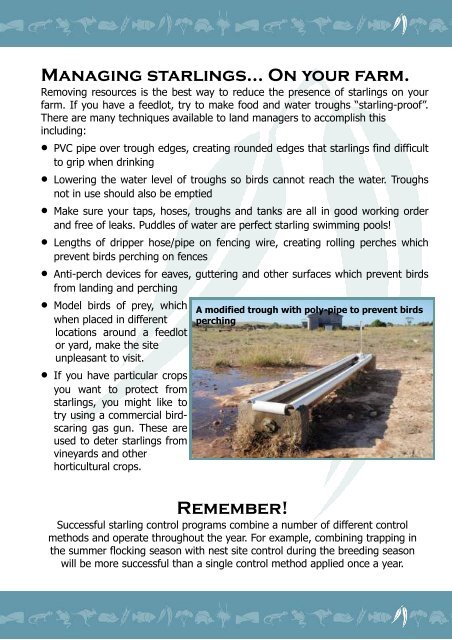starling control methods_brochure_Final Draft (Read-Only)
starling control methods_brochure_Final Draft (Read-Only)
starling control methods_brochure_Final Draft (Read-Only)
You also want an ePaper? Increase the reach of your titles
YUMPU automatically turns print PDFs into web optimized ePapers that Google loves.
Managing <strong>starling</strong>s… On your farm.<br />
Removing resources is the best way to reduce the presence of <strong>starling</strong>s on your<br />
farm. If you have a feedlot, try to make food and water troughs “<strong>starling</strong>-proof”.<br />
There are many techniques available to land managers to accomplish this<br />
including:<br />
• PVC pipe over trough edges, creating rounded edges that <strong>starling</strong>s find difficult<br />
to grip when drinking<br />
• Lowering the water level of troughs so birds cannot reach the water. Troughs<br />
not in use should also be emptied<br />
• Make sure your taps, hoses, troughs and tanks are all in good working order<br />
and free of leaks. Puddles of water are perfect <strong>starling</strong> swimming pools!<br />
• Lengths of dripper hose/pipe on fencing wire, creating rolling perches which<br />
prevent birds perching on fences<br />
• Anti-perch devices for eaves, guttering and other surfaces which prevent birds<br />
from landing and perching<br />
• Model birds of prey, which<br />
when placed in different<br />
locations around a feedlot<br />
or yard, make the site<br />
unpleasant to visit.<br />
• If you have particular crops<br />
you want to protect from<br />
<strong>starling</strong>s, you might like to<br />
try using a commercial birdscaring<br />
gas gun. These are<br />
used to deter <strong>starling</strong>s from<br />
vineyards and other<br />
horticultural crops.<br />
A modified trough with poly-pipe to prevent birds<br />
perching<br />
Remember!<br />
Successful <strong>starling</strong> <strong>control</strong> programs combine a number of different <strong>control</strong><br />
<strong>methods</strong> and operate throughout the year. For example, combining trapping in<br />
the summer flocking season with nest site <strong>control</strong> during the breeding season<br />
will be more successful than a single <strong>control</strong> method applied once a year.

















